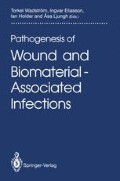Summary
Animals models have been developed which seek to 1) investigate skin colonization with pathogens 2) mimic skin and wound infections 3) provide a mechanism for the study of virulence determinants in the infectious process 4) determine the efficacy of anti-infective agents and 5) investigate pathogens under in vivo conditions.
Access this chapter
Tax calculation will be finalised at checkout
Purchases are for personal use only
Preview
Unable to display preview. Download preview PDF.
References
Kinsman O. Models for staphylococcal colonization and skin infections. In experimental models; in Antimicrobial Chemotherapy Vol 2: 133–46, Academic Press Inc (London) 1986.
James RC, MacLeod CJ. Induction of staphylococcal infections in mice with small inocula introduced on sutures. Br J Exp Pathol 42: 266 – 77, 1961.
Goldschmidt F. Reproducible topical staphylococcal infection in rats. Appl Microb 23: 130 – 34, 1972.
Boon RJ, Beale AS, Sutherland R. Efficacy of topical mupirocin against an experimental Staphylococcus aureus surgical wound infection. J Antimicrob Che-mother 16: 519 – 26, 1985.
Noble WC. The production of subcutaneous staphylococcal lesions in mice. Br J Exp Pathol 46: 254 – 62, 1965.
Taubier JH, Kapral FA, Mudd S. Role of alpha toxin in lesion formation by Staphylococcus aureus on sutures subcutaneously implanted in mice. J Bacteriol 86: 51 – 57, 1963.
Kinsman O. A review of mouse models of staphylococcal colonization and infection. In: Experimental bacterial and parasitic infections 65–73, Elsevier, 1983.
Patel AH, Nowlan P, Weavers ED, Foster T. Virulence of protein A-deficient mutants of Staphylococcus aure-us by allele replacement. Infect Immun 12: 3103 – 10, 1987.
Shibl AM. Subcutaneous staphylococcal infections in mice: the influence of antibiotics on extracellular products. Chemother 28: 46 – 53, 1982.
De Azavedo JCS, Russell RJ. A simple method for study of bacterial characteristics and growth in vivo. Immunochemical and molecular genetic analysis of bacterial pathogens. Ed. P Owen, TJ Foster, Elsevier, 1988.
Gladstone GP, Glencross EJG. Growth and toxin production of staphylococci in cellophane sacs in vivo. Br J Exp Pathol 41: 313 – 33, 1960.
Lam GT, Sweeney FJ, Witner CM, Wise RI. Abscess forming factors produced by Staphylococcus aureus I. Colloidin bag implantation technique. J Bacteriol 86: 611 – 15, 1963.
Veale DR, Smith H, Witt K, Marshall RB. Differential ability of colonial type of Neisseria gonorrhoea to pro-duce infection and an inflammatory response in subcutaneous perforated plastic chambers in guinea pigs and rabbits. J Med Microbiol 8: 325 – 35, 1975.
Arko RJ. Neisseria gonorrhoeae experimental infection of laboratory animals. Sci 177: 1200 – 01, 1972.
Knoll I-I, Holm SE, Gerlash D, Kuhnemund O, Kohler W. Tissue cages for study of experimental streptococcal infection in rabbits. II Humoral and cell mediated immune responses to erythrogenic toxins. Immunobiol 169: 116 – 27, 1985.
Davey PG, Barza M, Stuart M. Tolerance of Pseudo-monas aeruginosa to killing by ciprofloxacin, gentamicin and imipenem in vitro and in vivo. J Antimicrob Chemother 21: 395 – 404, 1988.
Day SEJ, Vasti KK, Russell RJ, Arbuthnott JP. A simple method for the study in vivo of bacterial growth and accompanying host response. J Infect 2: 39 – 51, 1980.
De Azavedo JCS, Foster TJ, Hartigan PJ, Arbuthnott JP, O'Reilly M, Kneisworth B, Novick RP. Expression of the cloned toxic shock syndrome toxin I gene TST in vivo with a rabbit uterine model. Infect Immun 50: 304 – 9, 1985.
Editor information
Editors and Affiliations
Rights and permissions
Copyright information
© 1990 Springer-Verlag London Limited
About this chapter
Cite this chapter
Kinsman, O.S., Arbuthnott, J.P. (1990). Pathogenesis of skin and wound infections. Animal models. In: Wadström, T., Eliasson, I., Holder, I., Ljungh, Å. (eds) Pathogenesis of Wound and Biomaterial-Associated Infections. Springer, London. https://doi.org/10.1007/978-1-4471-3454-1_14
Download citation
DOI: https://doi.org/10.1007/978-1-4471-3454-1_14
Publisher Name: Springer, London
Print ISBN: 978-3-540-19596-2
Online ISBN: 978-1-4471-3454-1
eBook Packages: Springer Book Archive

